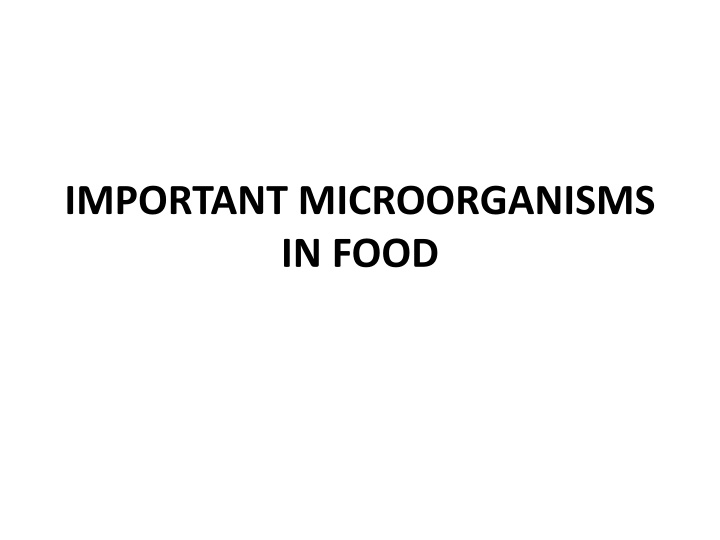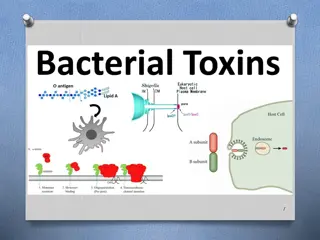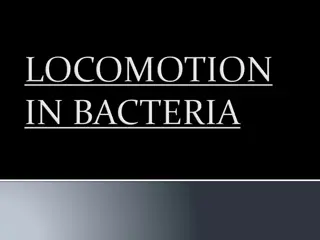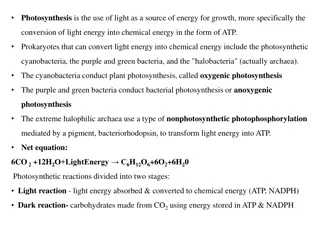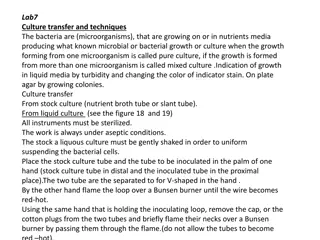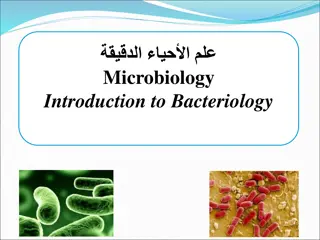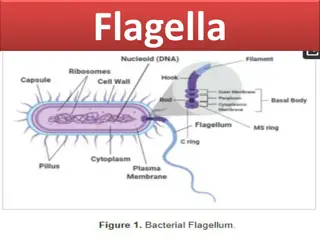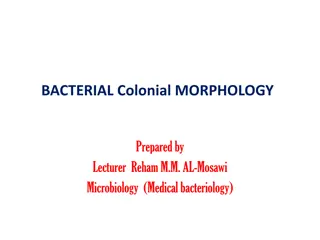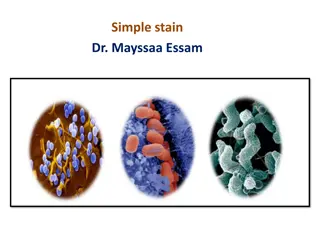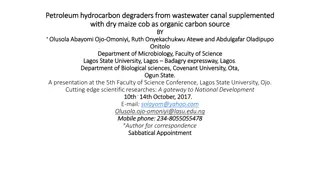Important Bacterial Groups in Food
Bacteria play a crucial role in food, with various groups such as Lactic Acid Bacteria, Acetic Acid Bacteria, Propionic Acid Bacteria, Butyric Acid Bacteria, Proteolytic Bacteria, Lipolytic Bacteria, Saccharolytic Bacteria, and Pectinolytic Bacteria identified for their specific roles in food fermentation, degradation, and transformation processes.
Download Presentation

Please find below an Image/Link to download the presentation.
The content on the website is provided AS IS for your information and personal use only. It may not be sold, licensed, or shared on other websites without obtaining consent from the author.If you encounter any issues during the download, it is possible that the publisher has removed the file from their server.
You are allowed to download the files provided on this website for personal or commercial use, subject to the condition that they are used lawfully. All files are the property of their respective owners.
The content on the website is provided AS IS for your information and personal use only. It may not be sold, licensed, or shared on other websites without obtaining consent from the author.
E N D
Presentation Transcript
IMPORTANT MICROORGANISMS IN FOOD
A. IMPORTANT BACTERIAL GROUPS IN FOODS Among the microorganisms found in foods, bacteria constitute major important groups. This is not only because many different species can be present in foodsbut also becuase of their rapid growth rate, ability to utilize food nutrients, and ability to grow under a wide range of temperatures, aerobiosis, pH, and water activity, as well as to better survive adverse situations, such as survival of spores at high temperature. For convenience, bacteria important in foods have been divided into several groups on the basis of similarities in certain characteristics. Some of these groups and their importance in foods are listed here.
1. Lactic Acid Bacteria They are bacteria that produce relatively large quantities of lactic acid from carbohydrates. Species mainly from genera Lactococcus, Leuconostoc, Pediococcus, Lactobacillus, and Streptococcus thermophilusare included in this group. 2. Acetic Acid Bacteria Most of the acetic acid belong to two genera Acetobacterand Gluconobacter. Both oxidize ethyl alcohol to acetic acid, but Acetobacteris capable of oxidizing acetic acid further to CO2. 3. Propionic Acid Bacteria They are bacteria that produce propionic acid and are used in dairy fermentation. Species such as Propionibacteriumfreudenreichiiare included in this group. 4. Butyric Acid Bacteria They are bacteria that produce butyric acid in relatively large amounts. Some Clostridium spp. such as Clostridium butyricumare included in this group
5. Proteolytic Bacteria They are bacteria that can hydrolyze proteins because they produce extracellular proteinases.Species in genera Micrococcus, Staphylococcus, Bacillus, Clostridium,Pseudomonas, Alteromonas, Flavobacterium, Alcaligenes, some in Enterobacteriaceae,and Brevibacteriumare included in this group. Some bacteria are putrefactive , they decompose proteins anaerobically to producefoul smelling compounds such as H2S, mercaptans, amines, indole. Ex: Clostridium, Proteus, Pseudomonas. 6. Lipolytic Bacteria They are bacteria that are able to produce lipases which catalyze the hydrolysis of fats to fatty acids and glycerol. Many of the aerobic, actively proteolytic bacteria also are lipolytic. Species in genera Micrococcus, Staphylococcus, Pseudomonas,Alcaligenes,Serratia ,Alteromonas, and Flavobacteriumare included in this group. Pseudomonas fluorescens Strongly lipolytic
7. Saccharolytic Bacteria They are bacteria that are able to hydrolyze complex carbohydrates (disaccharides or polysaccharides) to simpler sugars. Species ingenera Bacillus, Clostridium, Aeromonas, Pseudomonas, and Enterobacterare included in this group. Amylolytic bacteria possess amylase to bring about the hydrolysis of starch outside the cell.Amylolytic bacteria are Bacillus subtilisand Clostridium butyricum. 8.Pectinolytic Bacteria: Pectins are complex carbohydrates that are responsible for cell wall rigidity in vegetables and fruits. Species ingeneraErwinia, Bacillus, Clostridum, Achromobacter, Aeromonas, Arthrobacter, Flavobacteriumare included in this group.
9. Thermophilic Bacteria Optimum temperature required for these bacteria 45 C - 55 C .Species from generaBacillus, Clostridium, Pediococcus, Streptococcus, and Lactobacillus are includedin this group.. Bacillus stearothermophilus thermophilic flat sour spoilage of low acid canned foods. 10.Thermoduric Bacteria They are bacteria that are able to survive pasteurization temperature treatment. Some species from Micrococcus, Enterococcus, Lactobacillus, Pediococcus, Bacillus (spores), and Clostridium (spores) are included in this group. Some thermoduric bacteria like Bacillus and enterococci can also be psychrotrophic. 11. Psychrotrophic Bacteria They are bacteria that are able to grow at refrigeration temperature.Unlike psychrophiles, psychrotrophs do not have their optimal temperature for growth at refrigeration temperature and their optimum between 25 C and 30 C. Somespecies from Pseudomonas, Alteromonas, Alcaligenes, Flavobacterium, Serratia,Bacillus, Clostridium, Lactobacillus, Leuconostoc, Carnobacterium, Brochothrix,Listeria, Yersinia, and Aeromonasare included in this group.
12.Halophilic Bacteria Halophilic Bacteria require certain minimal concentrations of dissolved sodium chloridefor growth. Ex: Pseudomonas, Moraxella, Acinetobacter, Flavobacterium, Vibrio spp. which grow best in media with 0.5 3.0 % salt. These are slightly halophilic. These bacteria are isolated from fish shell fish. Moderate halophiles are grown in the media containing 3.0 15% salt. Such as salted fish, brined fish, brined meats and some salted vegetables. Extreme halophiles grow in the heavily brined foods 15 30% salt. EX: Halobacterium, Halococcus. 13.Halotolerant Bacteria Halotolerant bacteria can grow with or without salt. Usually they are capable of growing in foods containing 5.0% salt or more. Ex: Bacillus,Micrococcus, Corynebacterium, pediococcus.
14. Aciduric Bacteria Acidoduric bacteria are able to survive at low pH (<4.0). Some species from Lactobacillus, Pediococcus, Lactococcus, Enterococcus, and Streptococcus are included in this group. 15.Osmophilic or Saccharophilic Bacteria: Osmophilic bacteria are those which grow in high concentrations of sugar. Ex: Leuconostoc. 16. Gas-Producing Bacteria They are bacteria that produce gas (CO2, H2, H2S) during metabolism of nutrients. Species from genera Leuconostoc, Lactobacillus (heterofermentative), Propionibacterium, Escherichia, Enterobacter, Clostridium, Bacillusand Desulfotomaculumare included in this group. Leuconostoc, Lactobacillus, Propionibacterium, produces only CO2. DesulfotomaculumproduceH2S . Other genera produce both CO2 and H2.
17.Slime or rope forming bacteria: They are bacteria that produce slime because they synthesize polysaccharides. Some species or strains from Xanthomonas, Leuconostoc, Alcaligenes, Enterobacter, Lactococcus, and Lactobacillus are included in this group. Alcaligenesviscolactis, Enterobacteraerogenescauses ropiness of milk and Leuconostocspp. producing slime in sucrose solutions . Micrococcus makes curing solutions for meats ropy. Lactobacillus plantarumand Lactobacilli may produced slime in various fruit, vegetable and grain products e.g. in cider, sauerkraut and beer. 18. Pigmented Bacteria: Colors produced by pigmented bacteria growing on or in foods. Flavobacterium Yellow to orange; Serratia Red; Halobacterium Pink
19. Coliform and Fecal coliform group: Coliforms are short rods that are defined as aerobic and facultative anaerobic, gram negative, non spore forming bacteria. Ex: Escherichia coli, Enterobacteraerogenes. Fecal coliform group includes coliforms capable of growing at 44 - 45 C. They are used as an index of sanitation. Some of the characteristics that make the coliform bacteria important in food spoilage are: 1. Their ability to grow well in a variety of substrates and synthesize most of the necessary vitamins. 2. Their ability of the group to grow well over a fairly wide range of temperatures from below 10 C to about 46 C. 3. Their ability to produce considerable amounts of acid and gas from sugars. 4. Their ability to cause off flavours often described as unclean or barny. 5. Their ability of E. aerogenesto cause sliminess or ropiness of foods. 20. Enteric Pathogenic bacteria Pathogenic Salmonella, Shigella, Campylobacter, Yersinia, Escherichia, Vibrio, Listeria and others that can cause gastrointestinal infection are included in this group.
B. Important Mold Genera Molds are important in foods because they can grow even in conditions in which many bacteria cannot grow, such as low pH, low water activity (aw), and high osmotic pressure. Many types of molds are found in foods.They are important spoilage microorganisms. Many strains also produce mycotoxins and have been implicated in foodborne intoxication. Many are used in food bioprocessing. Finally, many are used to produce food additives and enzymes. Some of the most common genera of molds found in food are listed here.
Aspergillus. It is widely distributed and contains many species important in food. Many are xerophilic (able to grow in low aw) and can grow in grains, causing spoilage. They are also involved in spoilage of foods such as jams, nuts, and fruits and vegetables (rot). Some species or strains produce mycotoxins(e.g., Aspergillusflavusproduces aflatoxin). Many species or strains are also used in food and food additive processing. A. nigeris used to process citric acid from sucrose and to produce enzymes such as b-galactosidase. Alternaria. Members are septate and form dark-colored spores on conidia. They causerot in tomatoes and rancid flavor in dairy products. Some species or strains producemycotoxins. Fusarium. Many types are associated with rot in citrus fruits, potatoes, and grains.They form cottony growth . Geotrichum. They grow,forming a yeastlike cottony, creamy colony. They establish easily in equipment and often grow on dairy products (dairy mold). Species: Geotrichum candidum.
Mucor.They produce cottony colonies. Some species are used in foodfermentation and as a source of enzymes. They cause spoilage of vegetables.Species: Mucorrouxii. Penicillium. It is widely distributed and contains many species. Some species are used in food production, such as Penicilliumroquefortiiand Pen. camembertiiin cheese. Many species cause fungal rot in fruits and vegetables. They also cause spoilage of grains, breads, and meat. Some strainsproduce mycotoxins Rhizopus. They causespoilage of many fruits and vegetables. Rhizopus stoloniferis the
C. Important Yeast Genera Yeasts are important in food because of their ability to cause spoilage. Many are also used in food bioprocessing. Some are used to produce food additives. Saccharomyces. Cells are round, oval, or elongated. It is the most important genus. Saccharomyces cerevisiaeare used in baking for leavening bread and in alcoholic fermentation. They alsocause spoilage of food, producing alcohol and CO2. Pichia. They form pellicles in beer, wine, and brine tocause spoilage. Some are also used in food fermentation.
Rhodotorula. They are pigment-forming yeasts and can cause discoloration of foodssuch as meat, fish, and sauerkraut. Torulopsis. They cause spoilage of milk because they canferment lactose. They also spoil fruit juice concentratesand acid foods. Candida. Many species spoil foods with high acid, salt, and sugar and form pellicleson the surface of liquids. Some can cause rancidity in butter and dairy products(e.g., Candida lipolyticum). Zygosaccharomyces. Cause spoilage of high-acid foods, such as sauces, ketchups,pickles, mustards, mayonnaise.
D. Important Viruses Viruses are important in food for three reasons. Some are able to cause enteric disease, and thus, if present in a food, can cause foodborne diseases. Hepatitis A have been implicated in foodborne outbreaks. Several otherenteric viruses, such as poliovirus, echo virus, and Coxsackie virus, can causefoodborne diseases. In some countries where the level of sanitation is not very high,they can contaminate foods and cause disease.
Some bacterial viruses (bacteriophages) are used to identify some pathogens (Salmonella spp., Staphylococcus aureus strains) on the basis of the sensitivity of the cells to a series of bacteriophages at appropriate dilutions. Bacteriophages are used to transfer genetic traits in some bacterial species or strains by a process called transduction (e.g., in Escherichia coli or Lactococcus lactis). Finally, some bacteriophages can be very important because they can cause fermentation failure. Many lactic acid bacteria, used as starter cultures in food fermentation, are sensitive to different bacteriophages. They can infect and destroy starter-culture bacteria, causing product failure.
